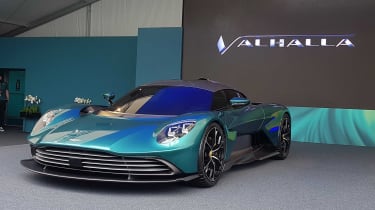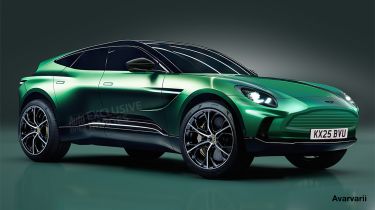.jpg)
Aston Martin has revealed the first steps on its journey towards an electric future, with the British brand to offer a fully electrified option of every core model in its line-up by 2030. Before this however, Aston’s first EV will break cover in 2025 – and we’ve already heard early technical details of the platform its cars will be based on and the motors that will power it, thanks to a new deal signed with American EV firm Lucid.
Aston is working on its own, in-house developed modular platform that will underpin everything from low GT and sports cars to higher-riding SUV models. At a recent briefing ahead of Aston’s Capital Markets Day for investors, Aston chairman Lawrence Stroll outlined that: “We were always building our own platform, our own chassis, it’s what we do very well.
“What was most important to me was to finding what is the greatest technology to give us high-performance,” he added. “We know how to do ultra-luxury, but what’s the best technology on the marketplace to accomplish our goal of having an SUV, having an EV on the market at launch in 2025 – which most of you guys doubted and never believed. Well, here we go. We believe Lucid represented the best existing, mature technology, with the highest horsepower, the lowest battery height to enable our EV strategy.”
The deal (worth £182 million, which allows Aston access to Lucid’s tech and also includes an ongoing supply cost) will see Aston use Lucid electronic drive units that incorporate the motors, inverter and the transmission on its cars’ rear axles. These will feature bespoke calibration and software for Aston Martin products, with Lucid chief executive and chief technology officer Peter Rawlinson highlighting that these EDUs will be based on existing Lucid tech. Currently, the maximum output of the tri-motor Lucid Air Sapphire stands at “more than 1,200bhp”, meaning the all-wheel drive saloon can sprint from 0-60mph in a claimed 1.89 seconds, offering a top speed of more than 200mph.
However, Aston’s CTO Roberto Fedeli confirmed to Auto Express that the British brand’s future models will use four motors, with a twin-motor drive unit of Aston’s own design for the front axle. This will most likely be influenced by the mid-engined Valhalla plug-in hybrid coming in 2024, which will use a similar front axle set-up.
“We are learning how to develop the front twin-motor axle for the next generation”, Fedeli said. He added that “A characteristic we like very much about Lucid’s components is the size. The size of the component is very well suited to our platform and the constraints that we have in order to create just one platform to support not just SUVs, but also sports cars.
“We want to be able to create [EV] cars with a roof height of a little bit less than the Vantage.” Fedeli went on to point out that this will mean we see battery modules packaged differently than the current convention of sandwiching them in the floor, with multiple modules positioned around the car potentially possible.
Rawlinson commented further on the power density of Lucid’s drive units – which fit inside a carry-on suitcase – saying that “Hyundai is at 1.1bhp per kg, a Tesla Model S Plaid is about 3.9bhp per kg, we’re at 9bhp per kg, so over twice as much. Our racing power unit looking towards the future is near to 17.”


Fedeli elaborated a little more on Aston’s future quad-motor set-up, highlighting a comparison between a digital test mule with four-motor torque vectoring and a current DBX707, with the new car outscoring the current model for dynamic ability on track. “You see what can happen when you apply this kind of technology? Four-wheel torque vectoring – there is no need to correct the car. What do you want in terms of power? 1,400bhp? 1,500bhp? It’s not a problem.”
First electric Aston Martin to take SUV form
Asked if the comparison between Aston’s first EV and the DBX707 was significant, if the 2025 car would take the form of an SUV, Fedeli nodded. As previewed by our exclusive image, it seems logical given the appetite in the market and the profit-making potential of these vehicles, and we’ll soon see test mules on the road, according to Aston’s top technology exec.
“Our target is to see the first mule running by the beginning of next year, the first mule to represent the platform – the most complicated model we want to develop on the platform has to be on the road by the beginning of next year. By the end of summer we are going to have the full powertrain on the test bench. We did the concept phase of the platform last year, this year we are completing this phase, and then we are going to start testing – first on the bench, then on the road.”
Advanced aerodynamics
Fedeli hinted that weight and aerodynamics will be key to the achieving the project’s goals, too. “Intensity. Driven. Emotion. That’s what will define it. Because we are building a BEV the weight could be a killer of the emotion and fun-to-drive – and not just the emotion, but the efficiency. The two pillars that are behind our concept of platform, concept of product, are emotion and efficiency.
“Aerodynamics is becoming the king. We have to manage the aerodynamics, and this could be done by using our partnership with the F1 team through simulation. We have some ideas about blowing the wake at the tailgate of the car in order to reduce the drag as much as possible. We are going to reduce the drag by 50 per cent, and this is what we need in order to avoid making the car heavy because of the energy we need on board for range.”
Expect Aston’s first EV to feature some funky aerodynamic solutions as a result, taking the energy from the aerodynamic flow at the front of the car and bringing it to the rear to “destroy the vortex”, according to Fedeli. “It means a huge reduction in drag”, he said.
Aston is also working on reducing the rolling resistance of its upcoming EV, with a clever brake-by-wire system from Brembo that controls the movement of the brake calipers’ pistons electronically, retracting them to reduce drag on the discs. A new P Zero tyre from Pirelli that features ‘Cyber Tyre’ tech that can sense loads on individual tyres is also under development.
Bold future plans for prosperity
The EV represents a new era for Aston, and chairman Stroll believes the company is well on track to achieve its financial turnaround targets. “I said to you that between 2024 and 2025 we would do £2billion in revenue and deliver £400 to £500million in earnings before costs – well, I can confirm to you today that we are well on the way to hitting those targets. We said that next year this company would be cashflow positive, that remains the case.”
Stroll was also spiky in his comments, however, following this by saying: “All of the heavy lifting I’ve done over the last three years that all of you have been very critical of, at times it pains me to read some of your comments and lack of appreciation of what it takes to turn an industrial company around. But I’m very happy to say, we’ve turned this place around.


“I’ve found all the capital for this company, I’ve just spent $300-odd million building a new F1 factory, plus hundreds of millions investment in the F1 team, I’ve saved thousands of jobs in this country – I should be knighted for what I’ve done.”
Stroll believes the real key is Aston’s future products however, and he has surrounded himself with people who have “seen the movie and written the script.”
“The key focus of every business is product,” he said, “The three most important things in any successful business are product, product, product.” Aston’s 2025 EV has a lot riding on it, then.
Now read more about the best electric SUVs you can buy right now…
